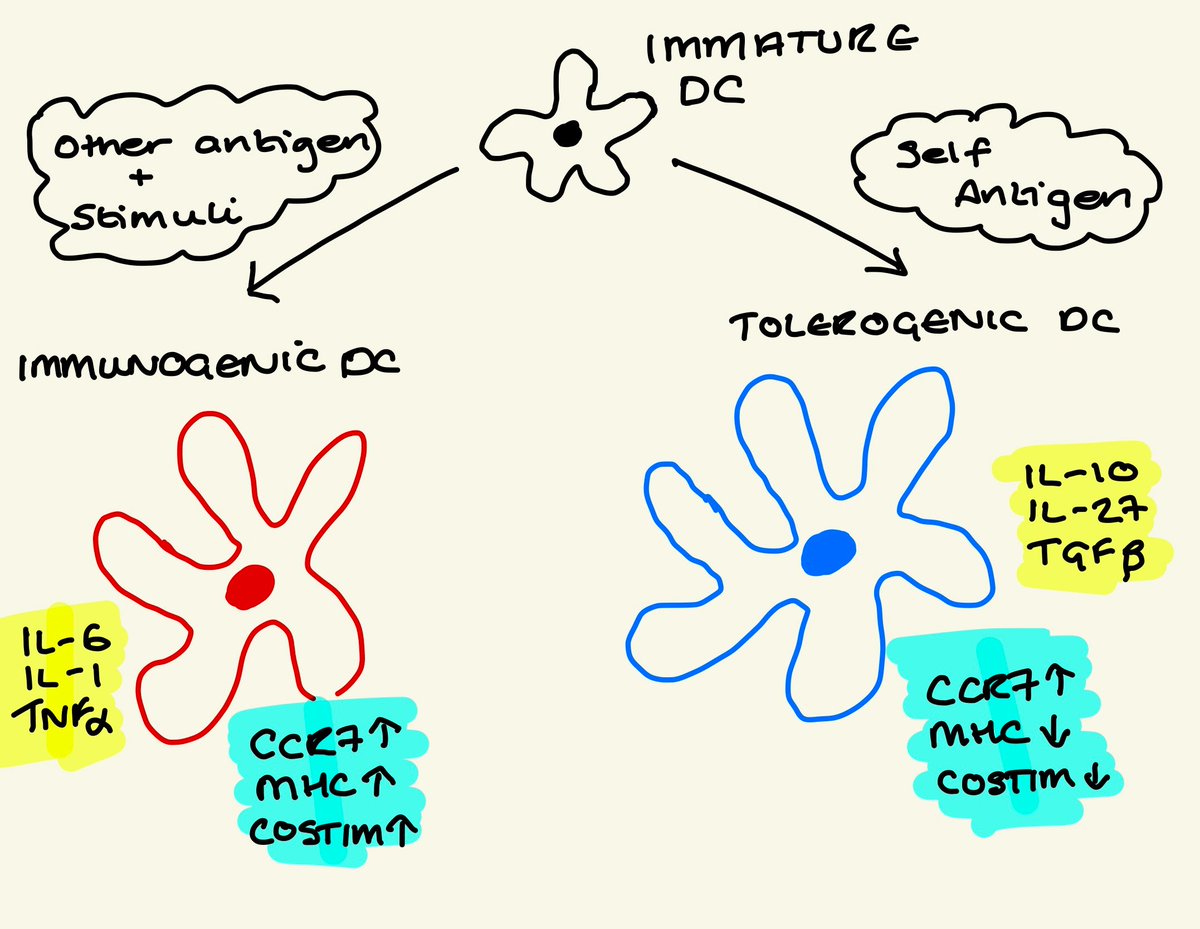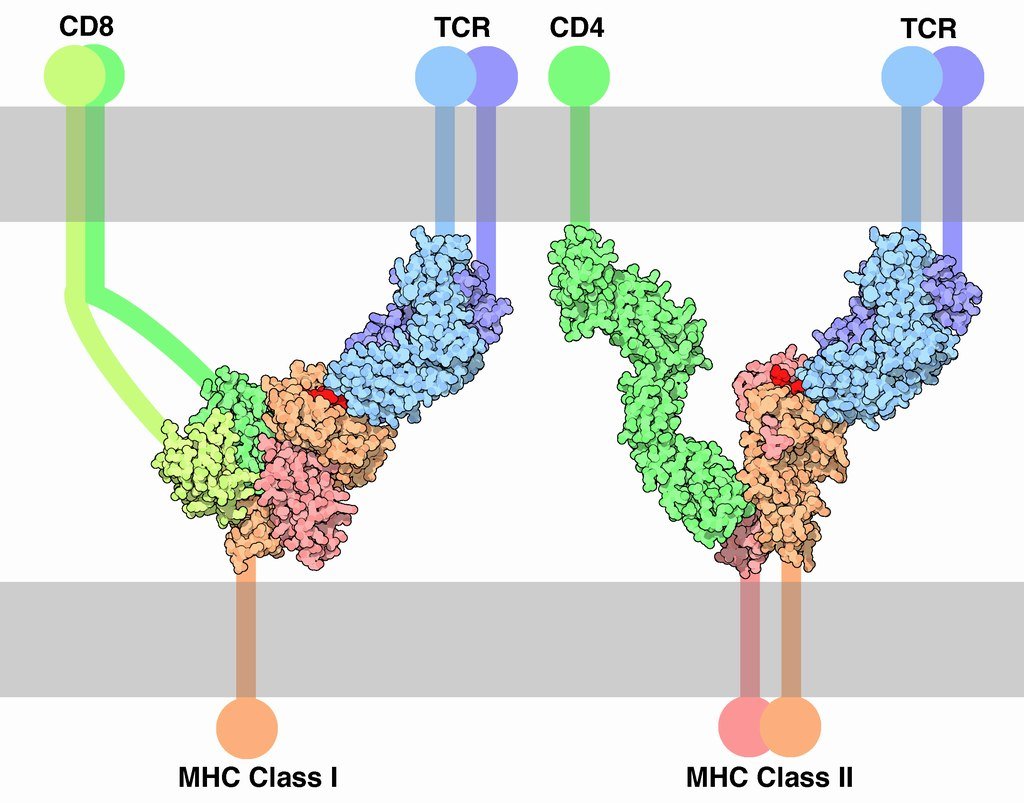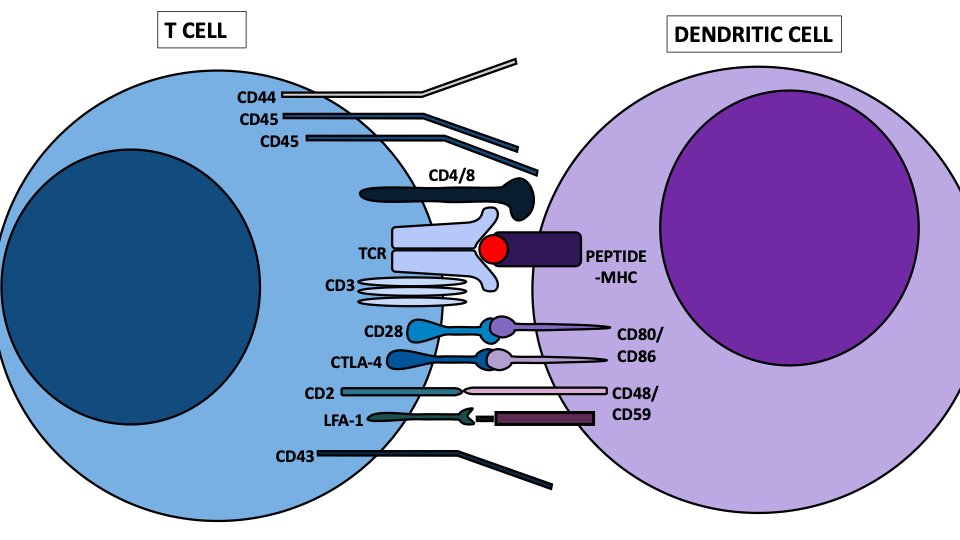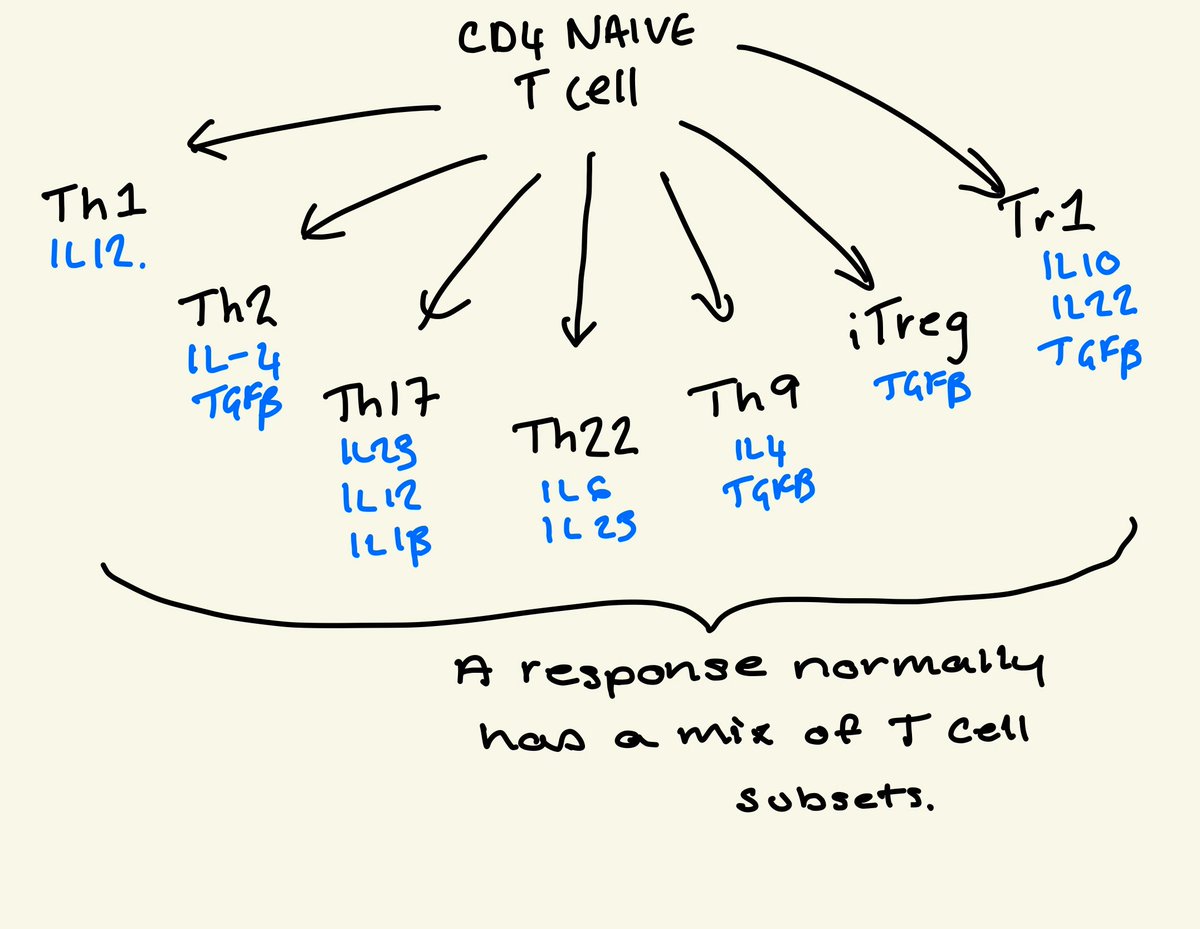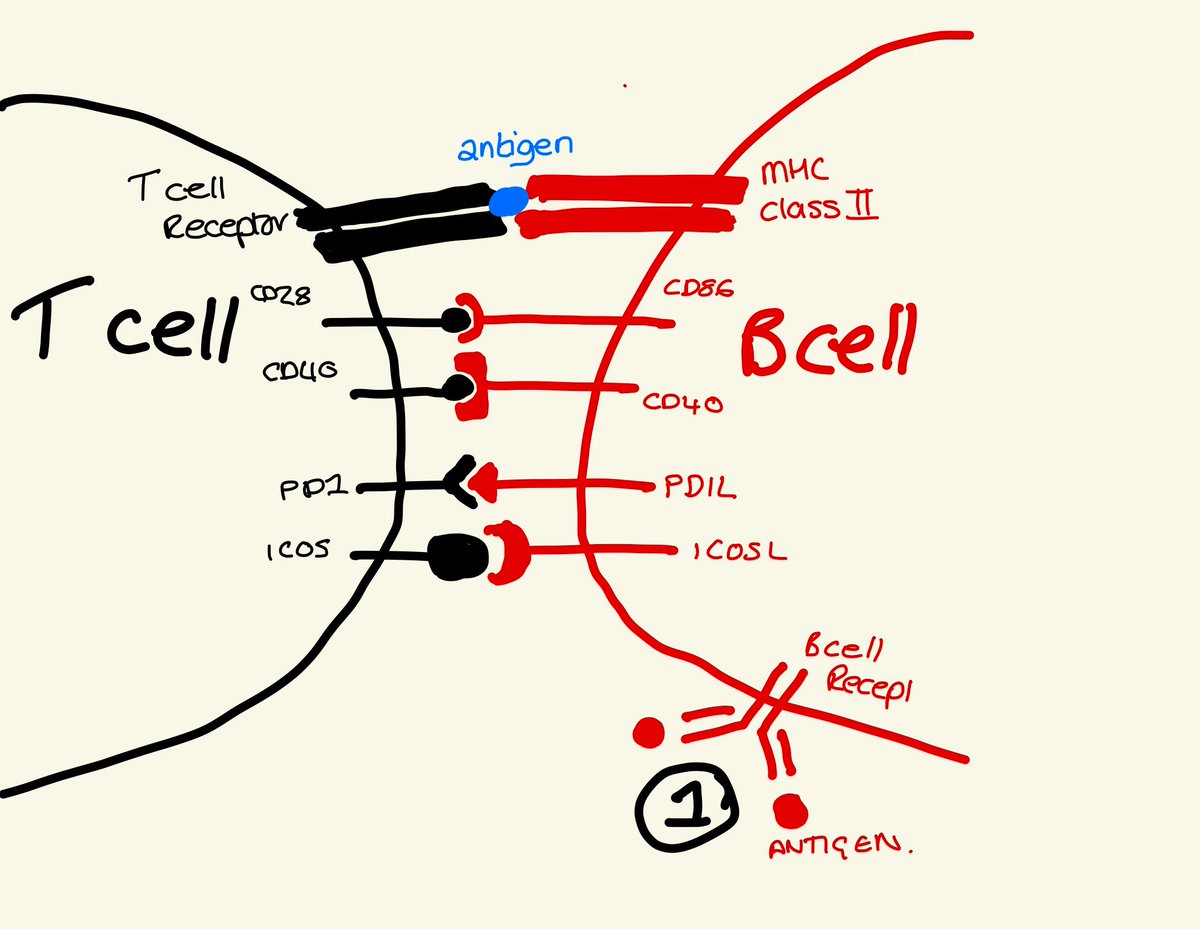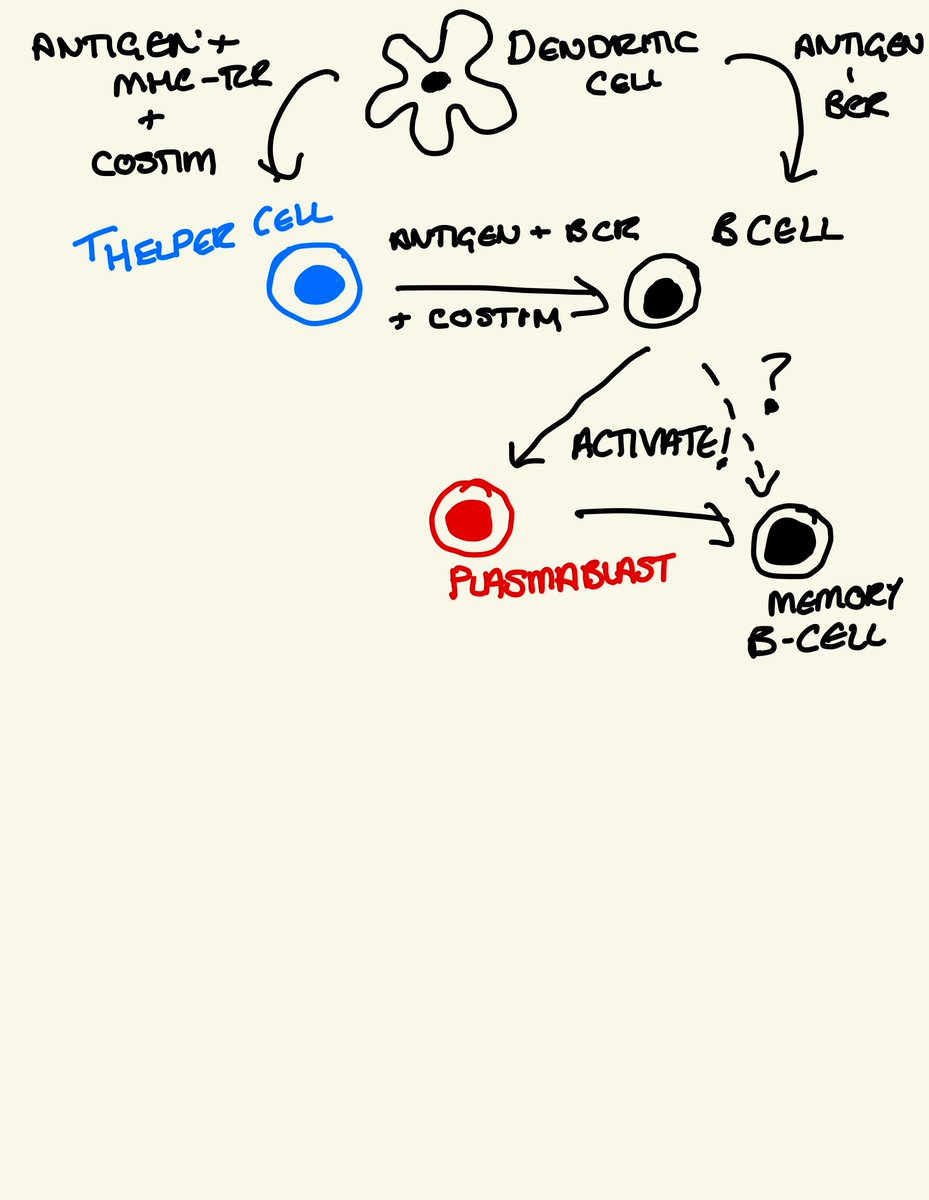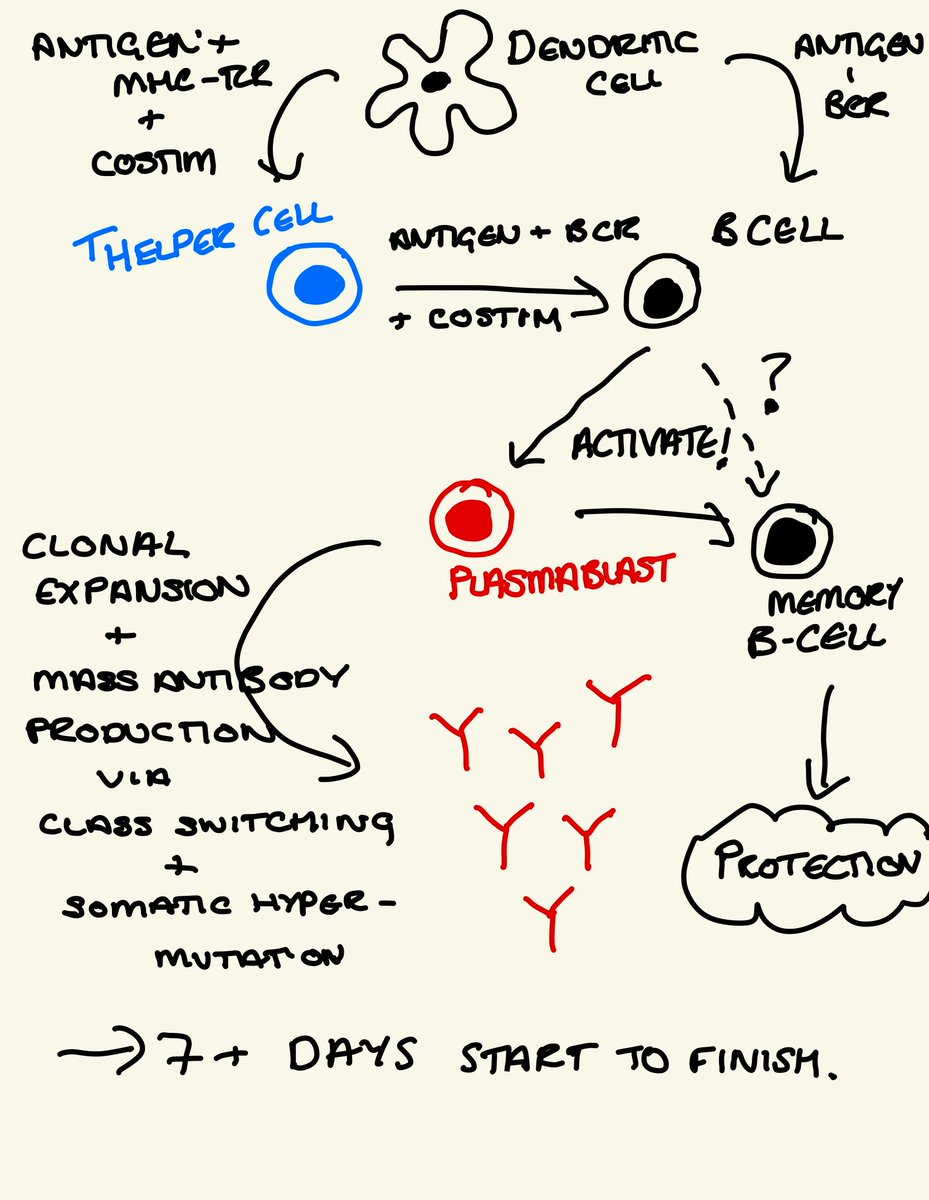So. Tweetorial 1.
I thought we would cover what happens during an adaptive immune response. .I'm going to break this up into parts over the next few days because this would be multiple lectures tbh
I thought we would cover what happens during an adaptive immune response. .I'm going to break this up into parts over the next few days because this would be multiple lectures tbh
We're going to start with a basic concept in immunology, that is going to end up resulting in something very complex...but its the 'domino' activation of immune cells. I like to teach this as the idea of transmission of instructions along a production line.
Adaptive immune responses are responses to specific little nuggets of proteins called 'antigens.' These are little chunks of protein stuff, they can be from you, from a bacteria, from a virus.
An immune response begins with an antigen presenting cell, a Dendritic Cell (DC). They are everywhere. In all your organs and tissues constantly sampling their environment. Once activated they pick up sticks and fly to the nearest lymph node, and can do 2 things.
They can be tolerogenic where they teach your immune system the antigen isn’t dangerous (I actually work on this) or immunogenic, where they then activate the rest of the immune system and choreographed hell breaks loose. Lets focus on them.
DC eat things, smash it to bits, and then 'present' the antigen on its surface on molecules called "major histocompatibility complex"s. These MHCs is actually what is matched during organ transplant etc, in order to help minimise immune rejection.
There are 2 types of MHC, which are creatively named MHC Class I, and MHC Class II. I is recognised by CD8+ "killer" T cells, and II is recognised by CD4+ "helper" T cells.
Yes. It's back to front. I don't know why. This happens a lot in immunology. We suck at naming things.
Yes. It's back to front. I don't know why. This happens a lot in immunology. We suck at naming things.
Side note: CD4 and CD8 are the co-receptors for the T Cell Receptor. Both cells have the same T Cell Receptor (TCR). The TCR is the same. The Co-receptor helps "stabilise" the TCR-MHC interaction, think of it as a stabaliser. CD8 stabalises TCR:MHC II and CD4 TCR:MHC I.
These process is antigen presentation. The MHC+antigen is recognised by either the CD8 or CD4 receptor on T cells, depending on the type of T cell.
Alongside this, there are multiple "co stimulation" molecules. These provide additional instructions to the T cell.
Alongside this, there are multiple "co stimulation" molecules. These provide additional instructions to the T cell.
When DC become immunogenic they increase expression of CD80/86. These bind to CD23 on T cells.
When you get MHC+antigen:TCR+coreceptor, and CD23:CD80/86, at the same time. The T cell gets the signal to turn on.
When you get MHC+antigen:TCR+coreceptor, and CD23:CD80/86, at the same time. The T cell gets the signal to turn on.
Both are required. One without the other will result in inactivation of the T cell.
We talk about these as "signals" so T cells need at minimum 2 signals to turn on.
We talk about these as "signals" so T cells need at minimum 2 signals to turn on.
This is a complex process, T cells and DC interact a lot. Think of it as a big make out session. This is sometimes called "the immunological synapse" because a large amoung of information in the form of receptor:ligand interactions.
Ok.
So now we have activated T cells. What's a T cell to do?
There is a signal 3.
These are in the form of cytokines, the things highlighted in yellow. These can help tell a T cell what action to take next.
So now we have activated T cells. What's a T cell to do?
There is a signal 3.
These are in the form of cytokines, the things highlighted in yellow. These can help tell a T cell what action to take next.
Different combinations of cytokines, produced by the DC the surroundings etc, will give rise to different subtypes of T cells. You will get a mix of these during an immune response. They all have slightly different jobs.
This is the first step of a long process, we'll talk about B cells and antibodies tomorrow.
As you can see we've gone from a DC picking up an antigen to now a complex, multifaced T cell response, with controls built in to prevent activation.
As you can see we've gone from a DC picking up an antigen to now a complex, multifaced T cell response, with controls built in to prevent activation.
Apologies this is late I have had a very anxiety and stress riddled week. How about we continue this since I was talking about antibody tests.
So how do we get from DC activating a CD4+ T cell, to an antibody, lets go.
So how do we get from DC activating a CD4+ T cell, to an antibody, lets go.
This is complex, so I'm gonna start with this diagram and every time we add a new step I'll update it and we can go through this stage by stage.
Lets refresh, we have two types of T cells, CD8+ T cells, your cytotoxic killer T cells (we’ll cover these in the next tweetorial), and CD4+ T cells, your helper T cells.
B cells, are another type of white blood cell and are mostly responsable for antibody production. They live in the lymph node, and before they can shack up with their CD4 T cell buddy they need a few shots first to get their courage up.
B cells will also recognise bits of pathogens that DC's bring with them. They can bind bits of foreign antigen with their B Cell Receptor, this receptor grabs bits of antigen, and primes the cell for activation. This basically says; "oi, this things here, kick its head in."
Guess what B cells also have!
MHC Class II! Just like Dendritic Cells do! Good old MHC to the rescue again!
Like DC, B cells also "present" antigen through MHC Class II.
In order for a B cell to get the message, it also needs telt twice.
MHC Class II! Just like Dendritic Cells do! Good old MHC to the rescue again!
Like DC, B cells also "present" antigen through MHC Class II.
In order for a B cell to get the message, it also needs telt twice.
Once by detecting the antigen itself and presenting it, and secondly, by the matching T cell, also telling it the same thing. Again, this is a failsafe, if one happens without the other B cells do not (normally) activate and produce antibodies.
Again, two signals are needed.
Again, two signals are needed.
It goes a little like this:
B cell: This is the THING right? The bad thing we need to get rid of? This is it? Right? Really?
T cell: Aye, aye thats it
B cell: You sure? Like DOUBLE sure?
T cell: Aye! C'mon move your arse theres antibodies you need to make.
B cell: This is the THING right? The bad thing we need to get rid of? This is it? Right? Really?
T cell: Aye, aye thats it
B cell: You sure? Like DOUBLE sure?
T cell: Aye! C'mon move your arse theres antibodies you need to make.
B cell activation occurs in your lymph nodes mostly. Activated CD4+ T cells, move through the lymph node, looking for the B cell buddy. It’s a little like trying to find your pals at a concert after you’ve gone to the bar and they’ve disappeared off into the mosh pit.
This deliverance of signal 2 to B cells, again requires direct contact, and we end up with multiple receptors binding to each other, to pass along information from the T helper cell, to the B cell.
The B cell activates and gets down to work.
The B cell activates and gets down to work.
Once these cells activate they undergo a two step differentiation process.
Both short-lived plasmablasts for immediate protection and long-lived plasma cells and memory B cells for persistent protection are generated.
Both short-lived plasmablasts for immediate protection and long-lived plasma cells and memory B cells for persistent protection are generated.
When turned on B cells start to divide and grow rapidly, again this is another example of clonal expansion. Plasmablasts that produce early, weak antibodies mostly of class IgM.
These IgM antibodies are not the best, but they are produced quickly and can help patch things before the B cells get down to serious business.
B cells are not here to play, they begin a process called class switching. They decide something stronger is needed.
B cells are not here to play, they begin a process called class switching. They decide something stronger is needed.
They begin producing IgG antibodies. Then, they being to make these antibodies even more efficient through somatic hypermutation - where the DNA that encodes the antibody gets shuffled around to make it super efficient at targeting the thing it's fighting.
B cells then begin producing these new antibodies on mass. millions and billions of B cells in your lymph node all chugging out these antibodies at breakneck speed - hence why your lymph nodes swell up when you are sick. They're busy making antibodies.
To do this takes DAYS.
To do this takes DAYS.
The process of physically manufacturing the volume of cells and antibodies needed to do this takes days, up to 10. Hence the lag between infection and the start of an immune response, and antibody production and pathogen clearence.
Antibodies can do a number of things, but prob the most important is that they bind to pathogens, covering them in antibodies, making it harder for viruses to infect new cells, and easier for the immune system to grab a hold of them and eat them and destroy them.
As the infection resolves, majority of these B cells will die, however some will persist as Memory B cells. These are capable of making efficient antibodies, so should you encounter the pathogen again – you are now so over levelled you can take it out easily.
Antibodies will also persist in your blood. We can test your antibody titre (level) by taking a blood sample and testing it – this will tell us if you have antibodies for a thing. You either have them because you have been exposed or you have been vaccinated.
Okay round three - today we're going to talk about CD8+ T cells. Also known as Cytotoxic T cells. Killer T cells.
Many names for one big bad boy of a cell.
These cells are not here to play, they came to kick ass and drink milk and they just finished their milk.
Many names for one big bad boy of a cell.
These cells are not here to play, they came to kick ass and drink milk and they just finished their milk.
CD8+ T cells are lymphocytes that possess the CD8+ co receptor. (See above tweets)
I mean, I think its pretty evident from their name, they kill cells. Their job is to track down either cancerous cells or infected cells and destroy them.
I mean, I think its pretty evident from their name, they kill cells. Their job is to track down either cancerous cells or infected cells and destroy them.
These cells are so potent and dangerous, they have a two step, two signal, activation system.
Like CD4+ Helper T cells above, they recognise antigen on dendritic cells except they recognise antigen bound to MHC class I, not MHC Class II.
Like CD4+ Helper T cells above, they recognise antigen on dendritic cells except they recognise antigen bound to MHC class I, not MHC Class II.
This two step process of dendritic cell + antigen + MHC Class I binding to the T Cell Receptor and coreceptor CD8, along with the co-stimulation we talked about before, primes the Killer T cell.
This instructs the Killer T cell “there is something really bad out there, go now."
This instructs the Killer T cell “there is something really bad out there, go now."
These cells are the airstrike cells of the immune system, they are about to rain down hell at the infection site.
They move to the infection site, where they can then start unleashing the some of the most destructive weapons the immune system has.
They move to the infection site, where they can then start unleashing the some of the most destructive weapons the immune system has.
What happens when a cell, say for example a cell in the lining of your airway gets infected with a virus?
Think about what we know so far?
ANTIGEN PRESENTATION!! Yas! Presentation of antigens from the virus will be presented on MHC class I.
Think about what we know so far?
ANTIGEN PRESENTATION!! Yas! Presentation of antigens from the virus will be presented on MHC class I.
Activation of a primed CD8+ T cell relies again on 2 signals:
1 - Antigen presentation from the infected cell - the TCR and CD8 coreceptor on the T cell bind to MHC Class I on the infected cell.
2 - Costimulation from the infected cell.
1 - Antigen presentation from the infected cell - the TCR and CD8 coreceptor on the T cell bind to MHC Class I on the infected cell.
2 - Costimulation from the infected cell.
When both conditions are met. The CD8+ T cell will kill the infected cell. This is another safety system. Your cells are constantly telling your immune cells, “its cool, I’m running as normal.” Your immune system sees this, then moves along. If its infected. It gets killed.
Ok so how do CD8+ T cells kill infected cells?
By punching holes in them and telling them to eff off and die. This is via production of two molecules, granzymes and perforins.
By punching holes in them and telling them to eff off and die. This is via production of two molecules, granzymes and perforins.
Granzymes are enzymes that tell the infected cell to go into apoptosis – programmed cell death. It activates caspases in the infected cell and once apoptosis starts it can not be stopped. The cell shuts down, destroys its own nucleus, DNA, RNA and dies. Bye bye bye cell.
The other class of molecules they release are called Perforins.
They quite literally punch a hole in the membrane of the cell. The cell explodes. Brutal and yet simple.
They quite literally punch a hole in the membrane of the cell. The cell explodes. Brutal and yet simple.
So in short CD8+ T cells did not come here to play. At all. They will force infected cells to kill themselves, or depending on its mood, throat punch it out of existence.
They are violence and destructive. Thus, they must be controlled.
They are violence and destructive. Thus, they must be controlled.
As you can imagine, this is hard work, like really hard work, they are making these molecules constantly, telling multiple cells to die, relentlessly trying to destroy infected cell after infected cell.
This is, most of the time, enough to get a virus under control.
This is, most of the time, enough to get a virus under control.
A feature we have seen repeatedly now in COVID19 patients who are severely ill and need ventilation, is their T cell population is very low in their blood, their T cells can’t keep up with the virus and they get exhausted. Yes, exhausted is the scientific term for it.
This is, another safety system, most infections can be cleared before the cells burn themselves, if not, the damage to the airway can become so great that you start to get in trouble. You can develop lung injury making it hard to get oxygen through your lungs into your blood.
Your immune system needs to clear the infection, but it also can not kill so many of its own cells that you can no longer breath. This is where things get tricky. The only way out is to support a patient while their immune system tries to catch up and they deal with it themselves
The exhaustion of CD8+ T cells means other cells in the immune system have to try and make up what’s missing – this normally falls to other cell types such as neutrophils and macrophages.
We’ll talk about them at some point soon.
We’ll talk about them at some point soon.

 Read on Twitter
Read on Twitter